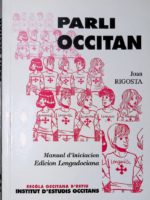Un libre ena The Katherin Golden Bittung Collection on Gastronomy.
Le Cuisinier gascon (1740)
0,00 €
Un libre ena The Katherin Golden Bittung Collection on Gastronomy.
| Category: | Estudis e monografics |
|---|---|
| Tags: | codina, especializacion, gascon, istòria, monografics, occitan |
| book-author | |
|---|---|
| format |

Per toti es publicacions
Pes libres en format papèr
En lengua occitana
Tòn equipa ath tòn servici
El Valle de Arán, tan caracterizado geográficamente por sus verdes praderas, sus tupidos bosques, sus arriscadas cimas, tiene también un habla que lo define: el aranés, que, como se nos dice en la introducción de este libro, no es propiamente un dialecto catalán, sino que está emparentado con el gascón, que se conserva todavía vivo entre las gentes del pueblo de los lugares del sur de Francia, que constituyen las históricas tierras de la Gascuña.
Casimiro Ademá, el autor de este estudio, aparte de poseer unos conocimientos poco comunes en la materia –aún no siendo un especialista en filología–, nos da de este fenómeno lingüístico un testimonio vivo y directo adquirido esencialmente en las conversaciones y convivencia con las gentes de su tierra.
Es nòms que designes es lòcs d’un territòri an ua foncion tecnica e culturau ath madesih temps. Tecnica perqué les referéncien geograficament, e culturau perqué veïculen ifnromacion sus era cultura, era lengua o es costums d’aqueri que les meteren eth nòm. En aguest sens, era toponímia aranesa ei un patrimòni collectiu que cau sauvagardar com a par der auviatge lingüistic e culturau dera Val d’Aran.
La langue d’oc ou occitan représente, à coté du catalan, du français, du francoprovencal, du castillan, [.] une des grandes langues romanes ou néo-latines qui se sont développées a partir d’une symbiose entre le latin populaire.
Pierre Bec ei professeur à l’Université de Poitiers, ancien Président de l’Institut d’Etudes Occitanes, ancien Directeur du Centre d’Etudes Supérieures de Civilisation Médiévale.
Se sap que, en el conjunt dels parlars romànics, no resulta excep- cional de trobar varietats lingüístiques que, en l’imperfet d’indicatiu de la segona i la tercera conjugacions, presentin a la desinència un so labial intervocàlic. Apareix, per exemple, dialectalment, en espanyol: en zones ben diverses, en clapes disperses, ja sigui en el vell o en el nou continent. Apareix en rètic o en dialectes itàlics: com, sense anar més lluny, en el toscà mateix. O bé també en aragonès, llengua en la qual «la terminación del imperfecto mantiene la -b- tanto en la primera como en la segunda y tercera conjugaciones» (ALVAR, 1953: 230) i en què aquestes formes amb un element bilabial —perquè, com en espanyol, hi és bilabial— a la desinència són, de fet, les formes referencials.
L’objectiu, doncs, no és de tractar d’afers —recurrents, per altra banda— com l’origen etimològic o analògic d’aquell so consonàntic, sinó sobretot de treure a la llum dades que hi fan referència: informa- cions obtingudes durant els darrers set anys arreu dels pobles de la Vall d’Aran —i també del Comenge veí, ja a l’Estat francès— a través d’enquestes de tipus dialectològic de format —diguem-ne— clàssic.
This is the first twentieth-century study of the women troubadours who flourished in Southern France between 1150 and 1250 — the great period of troubadour poetry. The book is comprised of a full-length essay on women in the Middle Ages, twenty-three poems by the women troubadours themselves in the original Provencal with translations on facing pages, a capsule biography of each poet, notes, and reading list.
En 1944, Manuel Abizanda e Broto deth Servicio de Defensa del Patrimonio Artístico Nacional publique era transcripcion e studi d’un manscrit titolat Índice Privilegios. Abizanda conde que dit manuscrit siguec amagat tà liurar-le deth perilh des “hodas rojas y marxistas” pendent era epòca Republicana e Guèrra Civila.
En 1938, un còp liberada era Val d’Aran pes nacionaus, er avocat Jaume Sala entreguèc dit manuscrit ath Servicio. Abizanda qu’ère agent d’aguest servici hec er estudi comentat adès.
En sòn trabalh ditz qu’un còp estudiat, eth manuscrit serà restituït entar Archiu Notariau, mès non especifique s’ei er archiu notariau deth districte de Vielha o parle d’un aute districte. Actuaument se desconeish a on se trape dit manuscrit e sonque auem notícies d’eth pera publicacion de 1944.
Pera descripcion hèta per Abizanda sabem qu’et manuscrit cònste de 50 fuelhs escrits e 40 fuelhs en blanc. Ei enquadernat en pergamin e mesure 14x10cm.
An edition and translation of some 30 poems by the trobairditz, a remarkable group of women poets from the 12th and 13th centuries, who composed in the style and language of the troubadours.

Be the first to review “Le Cuisinier gascon (1740)”
You must be logged in to post a review.